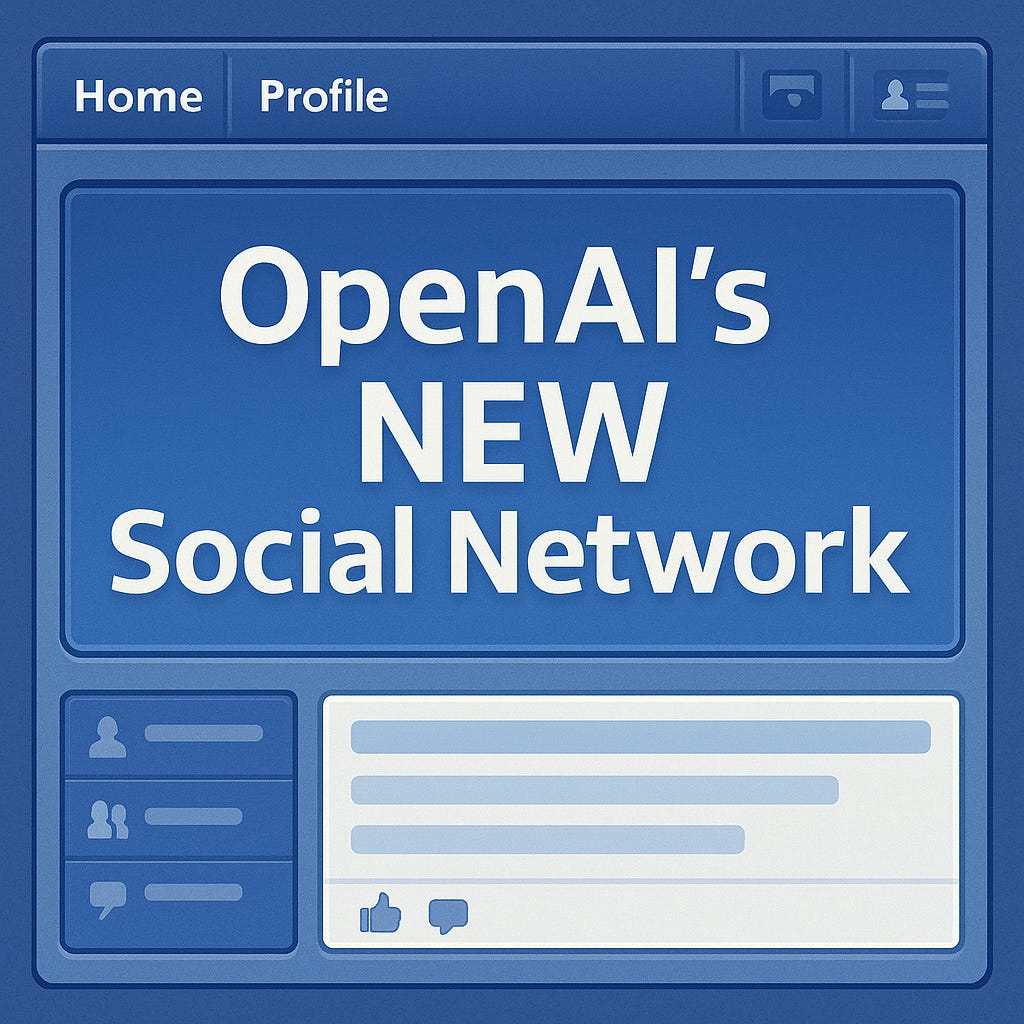So OpenAI launched Sora 2, but really they launched a social network. And it’s a big enough deal for all of us that I want to write a free and open post about it.
We’re all social media users. We should all get to debate whether this is a good thing or not, so sound off in the comments!
OpenAI Just Launched a Social Network. Here’s Why That Actually Makes Sense (for them)
OpenAI dropped Sora 2 last week, and the internet immediately started asking the same question: why is a chat company building Instagram?
The answer tells you everything about where OpenAI is headed, and it’s not what most people think.
First, let’s get the obvious part out of the way. Sora 2 isn’t just a video generation tool. It’s a social network, full stop. You create videos, you share them with friends, you insert yourself as a cameo into AI-generated clips and send them back and forth. It’s designed for the kind of ephemeral, playful interaction that used to define early Facebook and Instagram, before they became algorithmic content mills.
The product itself represents a meaningful step forward from Sora 1. Remember that splashy launch earlier in 2024 with the beautiful demo page? And then the somewhat underwhelming reality when it actually shipped a few months later? OpenAI clearly learned from that. Sora 2 generates videos up to 16 seconds now, the sound is better, and most importantly, they’ve thought hard about what kind of social experience they want to create. They didn’t just ship a tool. They shipped a context for how that tool should be used. And it’s immediately useful (by invite at least).
Reading the text (and subtext) from launch: OpenAI is terrified of being associated with AI slop.
They’ve watched Meta get absolutely hammered in the press for AI girlfriends, fake charity scams, and generally making the internet worse. They’ve seen the perception calcify that AI is ruining social media, filling it with synthetic garbage that nobody asked for. And they know that if ChatGPT becomes synonymous with low-quality AI content flooding the web, they’re cooked.
So Sora 2 is their answer. It’s a proof point that AI can power positive, creative interaction between real people. You can’t use Sora 2 without using AI, but you’re not using it to spam or scam or generate slop. You’re using it to make something genuinely fun with your friends. The viral feature, the cameo insertion where you cast yourself and your friends into videos and send them back and forth, is brilliant precisely because it’s inherently social and inherently AI-powered. You simply can’t do this without the technology, but the technology is in service of genuine human connection.
Even if Sora 2 doesn’t become the next big social platform, it’s still a win for OpenAI because it demonstrates a constructive path forward. That matters more than most people realize, especially right now when the narrative around AI and social media is so toxic.
This is also functioning as training wheels for a generation of people learning to be creative with AI in new ways. The interactions are low-stakes, the format is forgiving, and the social context makes it feel natural rather than intimidating. That’s valuable infrastructure for OpenAI’s long-term vision.
But let’s talk about the elephant in the room: monetization.
OpenAI is building toward a billion users, likely this year. And there’s a gravitational pull on the internet that’s hard to resist. When you hit that scale, you either become an ad network or you’re leaving massive amounts of money on the table. Look at every consumer app that’s ever reached this scale. They all end up in the same place: attention plus relationships equals ads.
The moves are already in motion. OpenAI just hired a head of monetization. They launched Pulse for pro users, which looks suspiciously like a feed that could accommodate sponsored content. They’re working with Etsy and Shopify on checkout within ChatGPT, which would give them the complete purchase funnel from discovery to transaction. And now they’ve launched Sora 2, which is basically a ready-made ad surface that doesn’t touch the core ChatGPT experience.
This is the strategic hedge. They can monetize through ads on new surfaces like Pulse and Sora 2 while keeping ChatGPT itself feeling trustworthy and uncompromised. You still go to ChatGPT for answers you can trust. But you get served ads when you’re scrolling through Pulse or watching Sora videos, where the stakes are lower and the context is different.
The persistent concern I keep hearing is about integrity. How do you maintain trust in a system that gives you answers when someone can pay to influence those answers? It feels like the kind of thing that rots a product from within. And OpenAI is clearly self-aware enough to know this is a problem they need to solve.
Launching separate surfaces might be how they thread that needle. You get ads in Pulse. You get ads on Sora 2. But they don’t touch ChatGPT itself, at least not initially. The core product maintains its reputation for trustworthiness while the newer, lower-stakes surfaces carry the monetization load.
I’m not saying this is the complete solution. They may eventually need to figure out how to responsibly integrate ads into ChatGPT itself. But starting with these other surfaces buys them time to figure out the right approach, and it gives them revenue without immediately compromising the product that built their brand.
The real question isn’t whether OpenAI will run ads. It’s whether they can pull off this balancing act, keeping the core product pristine while building new surfaces that generate revenue without generating backlash.
The timing here is also worth noting. They launched Sora 2 right before the holidays, which means they’re clearly thinking about Q4, about Black Friday and Cyber Monday, about getting telemetry on how people interact with this kind of product during peak shopping season. Even if they’re not running ads yet, they’re gathering the data they’ll need to make smart decisions about monetization down the line.
And there’s a competitive dimension to this launch that goes beyond just beating other AI labs to market. They’re stealing a march on Google, Snap, and Meta. All three will now be looking at how to get into this space, but OpenAI has first-mover advantage on the specific format of AI-powered social interaction between friends.
Google is currently leaning hard into Gemini Nano everywhere you look. TV ads, TikTok ads, ads across the internet. They’re pushing Lovable during this build week. It’s a bit of a defensive play, trying to keep attention on their cool thing so you don’t get too distracted by OpenAI’s cool thing. But they haven’t launched anything in the social network space in years, and there’s a reason for that. It’s hard.
Meta is actively building in this direction, but they’ve been getting absolutely roasted in the press for how they’re approaching AI on their platforms. The AI slop problem is real for them, and their brand reputation is suffering. OpenAI has a chance to position themselves as the responsible alternative, the company that figured out how to make AI social without making social media worse.
And Snap? Snap should genuinely be worried.
Snap built its entire business on ephemeral, friend-to-friend interaction. That’s exactly what Sora 2 is designed for. The difference is that Sora 2 has AI superpowers baked in from day one, and it’s launching on top of ChatGPT’s massive existing user base. If OpenAI can nail the product experience and build the right culture early (which is why it’s invite-only right now), they could genuinely steal a march on Snap in a way that feels inevitable in retrospect.
The choice to go friend-oriented rather than content-oriented is interesting. They could have built something more like TikTok, focused on algorithmic content discovery and creator monetization. Instead they’re going for the old Facebook model, the old Instagram model, where it’s fundamentally about you and your friends. That’s a bet on a specific kind of social graph and a specific kind of interaction pattern.
It’s early days. I remember when Threads launched and everyone thought it was going to be the Twitter killer, and then we watched the long, complicated fallout as people tried to figure out what Threads actually was and whether they wanted to use it. Sora 2 is on day one right now. The culture that develops around it, the ecosystem of creators they attract during this invite-only phase, the norms that get established early, all of that will determine whether this actually works.
But the strategic logic is clearer than most people realize. OpenAI isn’t pivoting. They’re not suddenly becoming a social media company because they ran out of ideas for AI. They’re showing you what they’ve been building toward all along.
So what is OpenAI, really? They’re not a chat company. They’re an intelligence company that’s figuring out how to wrap delightful experiences around that intelligence at massive scale. Chat is one interface. A social network is another. Checkout is another. Pulse is another. These all make sense once you stop thinking about OpenAI as a product and start thinking about them as a platform.
The beating heart of the company is the billion-user base. Everything else follows from that. The enterprise arm and the R&D arm help with profitability and the P&L, but the consumer brand is what keeps the engine running. Part of why enterprise customers have ChatGPT on the table is because everyone has heard of it. You need that popular support even on the B2B side. Brand perception at consumer scale matters for everything else the company does.
And here’s the thing that makes this inevitable: OpenAI would be the only billion-user company that isn’t an ad network if they didn’t do ads. They would be the only billion-user company that isn’t a social network if they didn’t do social. There are centers of gravity on the internet. When you get to a certain scale, you head toward ads and you head toward social. It’s just what happens. It’s how you make money off relationships and attention at scale.
The question was never whether OpenAI would get into these businesses. The question was always how they’d do it, and whether they could do it without compromising the thing that made them valuable in the first place.
Sora 2 is their first real answer to that question. We’ll see if it works.











